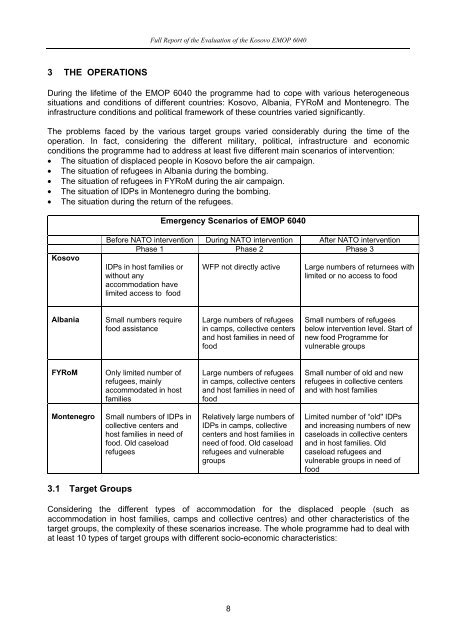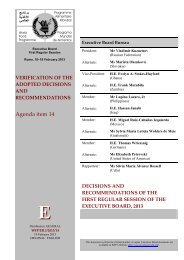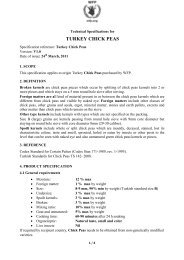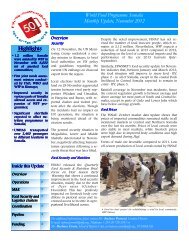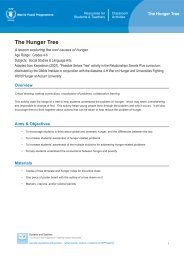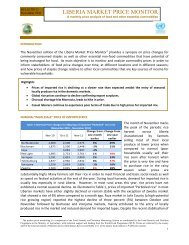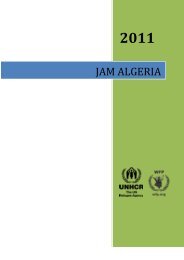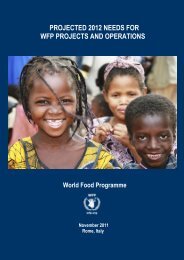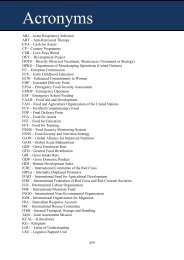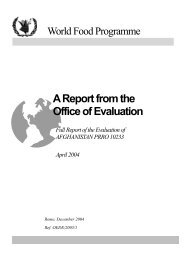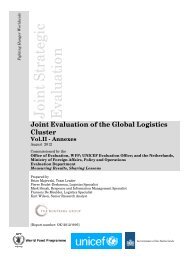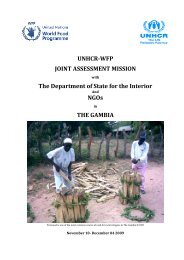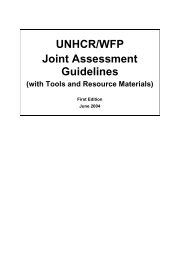Full Report - WFP Remote Access Secure Services
Full Report - WFP Remote Access Secure Services
Full Report - WFP Remote Access Secure Services
Create successful ePaper yourself
Turn your PDF publications into a flip-book with our unique Google optimized e-Paper software.
3 THE OPERATIONS<br />
<strong>Full</strong> <strong>Report</strong> of the Evaluation of the Kosovo EMOP 6040<br />
During the lifetime of the EMOP 6040 the programme had to cope with various heterogeneous<br />
situations and conditions of different countries: Kosovo, Albania, FYRoM and Montenegro. The<br />
infrastructure conditions and political framework of these countries varied significantly.<br />
The problems faced by the various target groups varied considerably during the time of the<br />
operation. In fact, considering the different military, political, infrastructure and economic<br />
conditions the programme had to address at least five different main scenarios of intervention:<br />
• The situation of displaced people in Kosovo before the air campaign.<br />
• The situation of refugees in Albania during the bombing.<br />
• The situation of refugees in FYRoM during the air campaign.<br />
• The situation of IDPs in Montenegro during the bombing.<br />
• The situation during the return of the refugees.<br />
Kosovo<br />
Emergency Scenarios of EMOP 6040<br />
Before NATO intervention During NATO intervention After NATO intervention<br />
Phase 1 Phase 2 Phase 3<br />
IDPs in host families or<br />
without any<br />
accommodation have<br />
limited access to food<br />
Albania Small numbers require<br />
food assistance<br />
FYRoM Only limited number of<br />
refugees, mainly<br />
accommodated in host<br />
families<br />
Montenegro Small numbers of IDPs in<br />
collective centers and<br />
host families in need of<br />
food. Old caseload<br />
refugees<br />
3.1 Target Groups<br />
<strong>WFP</strong> not directly active Large numbers of returnees with<br />
limited or no access to food<br />
Large numbers of refugees<br />
in camps, collective centers<br />
and host families in need of<br />
food<br />
Large numbers of refugees<br />
in camps, collective centers<br />
and host families in need of<br />
food<br />
Relatively large numbers of<br />
IDPs in camps, collective<br />
centers and host families in<br />
need of food. Old caseload<br />
refugees and vulnerable<br />
groups<br />
8<br />
Small numbers of refugees<br />
below intervention level. Start of<br />
new food Programme for<br />
vulnerable groups<br />
Small number of old and new<br />
refugees in collective centers<br />
and with host families<br />
Limited number of “old" IDPs<br />
and increasing numbers of new<br />
caseloads in collective centers<br />
and in host families. Old<br />
caseload refugees and<br />
vulnerable groups in need of<br />
food<br />
Considering the different types of accommodation for the displaced people (such as<br />
accommodation in host families, camps and collective centres) and other characteristics of the<br />
target groups, the complexity of these scenarios increase. The whole programme had to deal with<br />
at least 10 types of target groups with different socio-economic characteristics:


